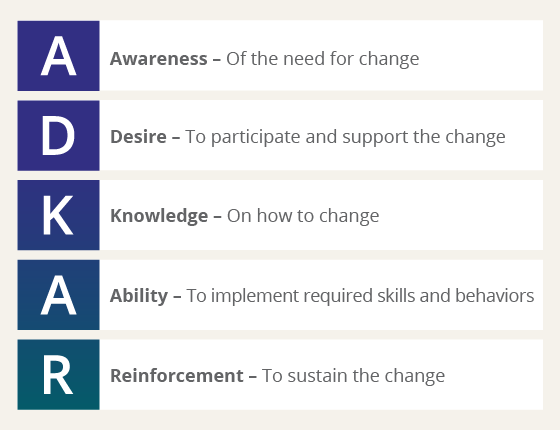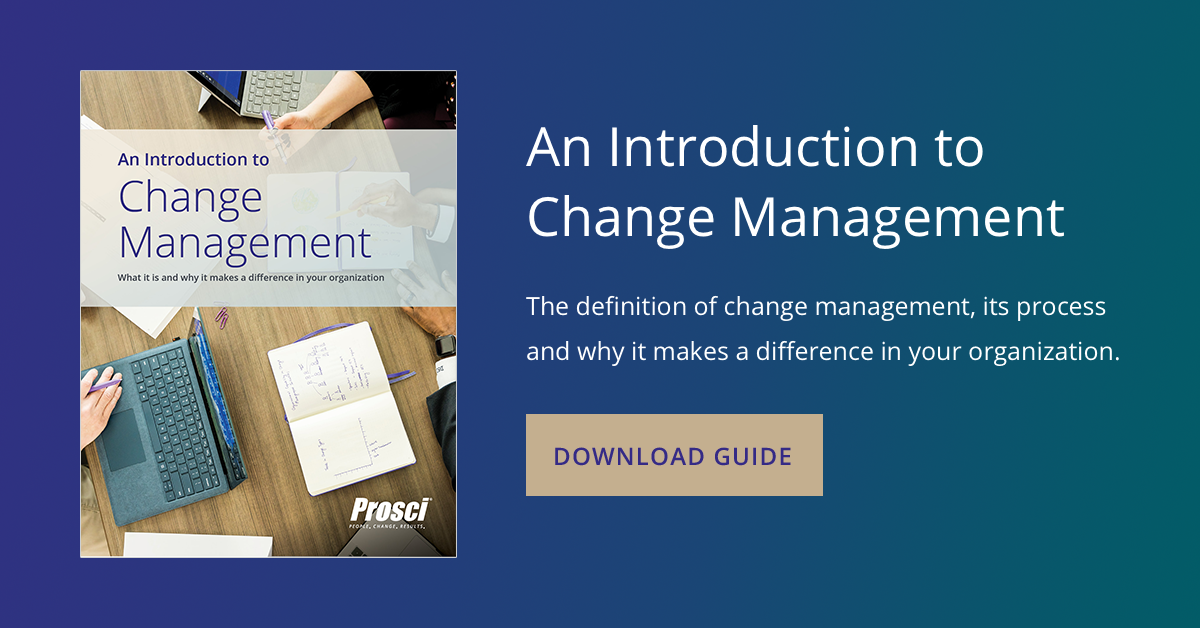The Common Denominator in Organizational Change

3 Mins
Updated: October 13, 2022
Published: April 19, 2017

Each month, Prosci delivers dozens of Change Management Certification Programs. To participate, attendees must bring a change they are currently working on in their organization, and then apply the process and tools learned during the class to a real change.
The changes attendees bring to the Prosci Change Management Certification Program come in all shapes and sizes: a technology deployment in an insurance company, a process optimization project in a manufacturing plant, a merger in the pharmaceutical industry, a new HR policy and system in a municipal government. Some of the changes impact a dozen employees while others impact thousands. Some have budgets in the thousands, while others have budgets in the millions.
The size, type and reasons for these projects are quite varied, but the unifier is that each project has a significant people-side element. Each change impacts how employees do their jobs. And the success of the project ultimately depends on whether employees adopt the required changes. This is why the people side of change is a common denominator in nearly any type of organizational change.
People: The Common Denominator
in Organizational Change
Changes happen for a number of reasons, each triggered by some sort of internal or external stimuli, and each aimed at delivering some sort of marked improvement in performance. Changes can be incremental or radical; sometimes the gap between the current and future state is small, and other times that gap is large. Changes can impact processes, technologies, systems, tools, structures, job roles or any combination of these factors. Some have little or no structure around them, some derive from policy declarations, and others are formal projects with associated project managers, project codes, project charters and work breakdown structures. Regardless of the reason, type or structure of the change, each ultimately impacts how individual employees do their jobs.
The common denominator of organizational change is the people side of change. Since the common denominator of organizational change is the people side of change and project success depends on impacted employees adopting the change, the tools for helping each impacted employee to adopt the change are critical to the success of the project. Said another way, change management is essential because the people side of change is universal.
What Does Your Change Look Like?
The chart below identifies 10 aspects of a person's job you can impact. Think about a change you are working on right now. Which of the aspects below will need your attention?

Consider two simple examples:
Example #1: A planned program in an insurance company aimed at increasing efficiency and improving customer satisfaction though a radical installation of new technologies and systems.
Example #2: An incremental process change resulting from an established continuous improvement system aimed at reducing errors in a food/beverage organization.
Although these two changes are unique in many ways, they share a key factor: their ability to deliver intended outcomes depends on individual employees doing their jobs differently (e.g., exhibiting new behaviors, following new processes, or using new tools). This is one of the reasons change management has emerged as a discipline over the last few decades. It is universally applicable to any change that impacts how people work.
What Can You Do About the People Side of Change?
- Work to define the individual changes required
This is necessary for every project you are involved with. It can sometimes be challenging, especially as the size and scope of change increases, but it is an important first step for understanding the reality of how changes occur in your organization. - Use a model for individual change
The Prosci ADKAR Model is one of the most widely used individual change management models. The ADKAR Model is an acronym for the five outcomes an individual needs to achieve to make a successful change: Awareness, Desire, Knowledge, Ability and Reinforcement. Whether at home, in the community or at work, an individual will make a change if they can say, "I have the awareness of why the change is happening. I have the desire to participate and support the change. I have the knowledge on how to change. I have the ability to implement the required skills and behaviors. And I have the reinforcement to sustain the change."

- Apply a structured organizational change management approach
In all of Prosci's benchmarking studies, the use of a structured approach for change management was identified as a top contributor to success. A structured organizational change management approach provides clarity on the roles, tools and activities required to enable and encourage individual transitions. An intentional approach to change management provides more consistent and repeatable outputs. The Prosci 3-Phase Process provides step-by-step instructions and tools for preparing your approach, managing change, and sustaining outcomes. Preparing for change, Managing change and Reinforcing change. And this process-driven approach enables scaling and customizing change management plans and activities to reflect the unique nature of the change and the groups being impacted.

